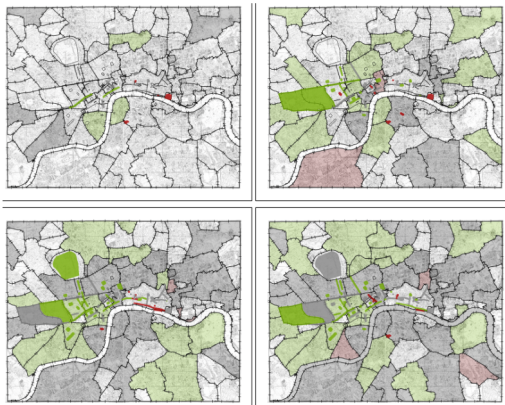As humans, we are defined by the place we come from. Speaking socially, where we come from has an immense impact on our values, mores, beliefs and the general way we perceive and understand the world around us. Since the beginning of borderification, the natural environment and the culture within these areas have become inherently linked. Many social, political and cultural issues of significant literary influence manifest themselves within this spatial dimension (eg. nationalism, gender and sexuality, environmentalism, imperialism, etc…). As such, the concept of place becomes deeply rooted in literature.
Conversely, it follows that through the analysis of old works of fiction, we are able to derive socio-cultural, spatially-relevant information that is not explicitly stated in the corpus. As a result, we are able to generate maps that can effectively illustrate the evolution of socio-cultural beliefs across time and space. In this blog post we’ll discuss this methodology in reference to three projects from DH2015 that address the implications of place in fictional literature and make use of this concept to reconstruct the elements of the past and track its influence on the presence.
Broadwell and Tangherlini (2015) explore the history of place through Danish folklore. Compared with other fictional works, folklore is especially deeply rooted in place. These ancient stories often rely heavily on institutional, environmental and demographic features. As such, they vary on a localized scale; even more so, as folk tales are transmitted by word-of-mouth, they are often restricted by topographical features. Based upon these principles, the authors created an accurate cartographic viewing environment that could be used to extract nuanced historical information from Danish folklore. 20,431 individual spatially referenced Danish legends are categorized based on several content-based attributes. Users can search for an arbitrary folkloric creature in the database, and other common features found in the same areas are returned. For example, a search for elves could return sparsely populated areas covered in woods and streams.
In principle, this project is promising. Folktales often predate more traditional recordings analyzed in the Digital Humanities; therefore this research has potential to help deduce previously un-catalogued historical information. However, at this stage this research seems to produce more questions than solutions: specifically, how can the presence or absence of certain creatures be used to realize the socio-cultural environment?
In comparison, one research group from Stanford University (Heuser et al., 2015) successfully tested a methodology to extract nuanced spatial details by deriving a relationship between historical place and the emotional setting in fictional works. Our initial, simplified definition of place is immediately complicated by the concept of “emotional investment”, whereby certain settings or structures in the natural and built environments evoke strong positive or negative sentiments. In this research, the authors used crowdsourcing to effectively annotate emotion from over 5,000 works of English-language fiction published in London between 1700 and 1900, in order to qualify and spatially delineate areas of emotional investment. Readers were assigned short setting-related passages and were asked whether the reading evoked happiness or fear. Statistical analysis showed that emotional investment (positive or negative) was determined principally by four criteria; the location within city (North, South, East, West), the function of the place (prison, church, square, etc…), the age of the place (Roman, Medeival or Tudor era) and social class. Thus, the resultant “emotional polarity” maps (Figure 1) of a fictional London enabled the researchers to systematically interpret relevant social and demographic information for historical London.
Figure 1: Emotional polarity maps for London depicting the spatial evolution of emotional investment from 1700 (top left) until 1900 (bottom right). The green polygons represent regions associated with happiness, red with fear, and greys indicate neutrality.
These two projects describe different manners in which non-explicit information about place can be determined through fictional literature. In both cases, texts are used to describe place a relatively long time ago. As previously discussed geographic and topographic borders provided strong limitations to the spatial distribution of information. As such, these two projects treat place as discrete elements or isolated polygons. In the modern world, globalization, the Internet, and social media have facilitated the quick and easy distribution of information across continents. Now, the concept of place is entirely different.
Travis effectively illustrates the dichotomy of historical and modern place in a crowdsourcing experiment where he tracks all social media activity related to James Joyce’s Ulysses throughout Bloomsday (2015). Ulysses is a prime example of the importance of place in fictional literature; Joyce once stated that the goal of the book was “to give a picture of Dublin so complete that if the city one day suddenly disappeared from the Earth it could be reconstructed out of my book” (Budgen, p. 69, 1972). In effect, the book is an exceptional case that alone expertly characterizes the socio-cultural aspects of place. Travis’ work goes beyond the historical description of place and attempts to analyze the influence this literary work has on modern place. Through Twitter, Flickr and YouTube, the author illustrates how one piece of place-specific literature can be proliferated and reinterpreted across the globe. As such, in a modern context the concept of place is continually building on our experience of place in the past.
The importance of place in fictional literature and story telling is well understood. This relationship is relevant to the field of Digital Humanities when descriptions of place can be analyzed to deduce important, yet elusive heritage information. In the present tense, social media facilitates the conversation around these fictional works and reconnects readers to representational space, effectively redefining the modern scope of place.
References
Budgen, F. (1972). James Joyce and the making of ‘Ulysses’. Oxford University Press, Oxford.
Broadwell, M., Tangherlini, T. (2015). ElfYelp: Geolocated Topic Models for Pattern Discovery in a Large Corpus
Heuser, R., Algee-Hewitt, M., Tran, V., Lockhart, A., Steiner, E. (2015). Mapping the Emotions of London in Fiction, 1700-1900: A Crowdsourcing Experiment
Travis, C. (2015). A Digital Humanities GIS Ontology: Tweetflickertubing James Joyce’s ‘Ulysses’ (1922)

